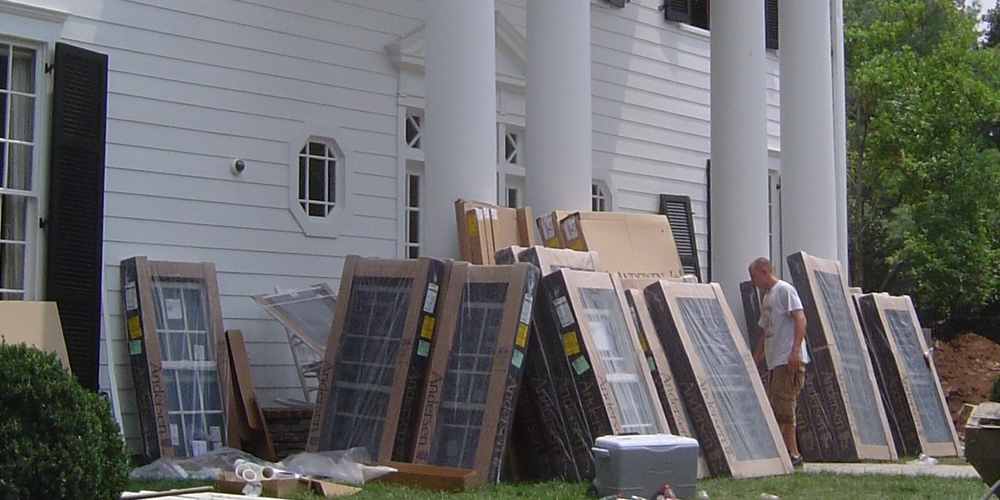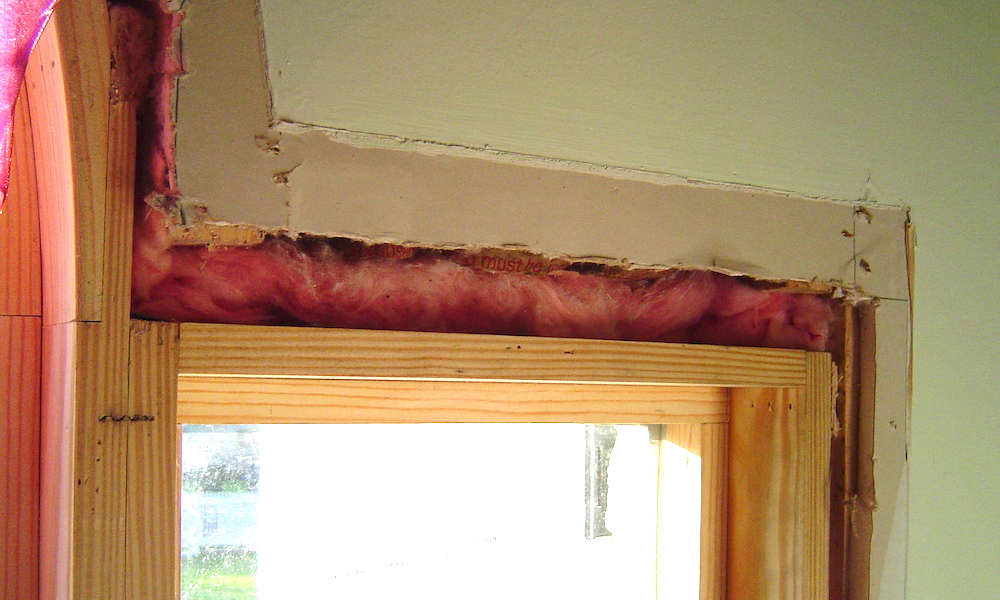Don’t Miss This Opportunity if You’re Replacing Windows

It kills me when I see homes getting their windows replaced. No, I’m not referring to the FTC’s recent slamming of the window industry for their overblown claims of energy savings. I’m talking about how a large number of window replacements miss a big opportunity that would help ensure they reduce energy usage as much as they can.
If you’re getting a window replaced completely, not just replacing the sashes, the trim comes off and the old window comes out entirely. When the installer sets the new window in the rough opening, the opportunity presents itslef…but too often is missed. That gap between the window frame and the hole it went into needs to be air-sealed.
If you have old windows, they can hurt you on heating and cooling in several ways:
- Single-pane windows transfer more heat through conduction.
- Metal-framed windows are superhighways for heat conduction.
- Without low-e coatings, old windows allow a lot more of the Sun’s heat to penetrate into the house (good for heating, not for cooling).
- The sashes of old windows are often loose in the frame and allow air to leak in.
- Air leaks in around the window frame in most older installations.
Replacing an old window with a new, insulated glass, low-e coated window can help with the first 4 of those problems. The last one in the list is the focus of this article. We’ve known for a long time now that we need to air seal homes and that it’s just a myth that “you shouldn’t make your home too tight.” Yet a lot of new windows still get installed as shown below.

This was an older home getting some of their windows replaced (not the same house shown above). The installer thought it was sufficient to stuff bits of fiberglass insulation into that gap. The truth, though, is that fiberglass is not an air barrier and should not be used there. Low expansion foam is probably the best option for sealing that gap.
I’ll leave the question of whether you should even bother replacing your windows for another article. (The quick answer is that it depends on what you have now and on your budget, but you probably shouldn’t if you’re just looking to make your home more energy efficient.) If you are replacing them, though, make sure to seal that gap properly. You’re not likely to have that opportunity again for a long time.
Allison A. Bailes III, PhD is a speaker, writer, building science consultant, and the founder of Energy Vanguard in Decatur, Georgia. He has a doctorate in physics and writes the Energy Vanguard Blog. He is also writing a book on building science. You can follow him on Twitter at @EnergyVanguard.
Related Articles
Insulation Does NOT Stop Infiltration
Myth: A House Needs to Breathe
Air Barrier Sleuthing – Building Envelope Lessons for DET Verifiers
Comments are closed.
This Post Has 11 Comments
Comments are closed.

I have always been told that
I have always been told that there are many reasons to replace windows:
1. Safety
2. Aesthetics
3. For ease of cleaning (whatever)
4. The neighbors just got them
5. They are non-operable
6. The current ones need painting
Energy efficiency is simply not a good reason. Most energy simulations show paybacks ranging from 29 to 99 years. That said, it remains the number one requested energy conservation measure requested by homeowners. It the homeowner wants them and can pay, your point on proper installation is right on.
Allison, Air sealing around
Allison, Air sealing around the frame of the window is one of the most often ignored opportunities for improved efficiency in a window installation, retrofit or new construction. I sell windows and help my contractor customers understand and execute proper installation. Another important aspect of the installation is water management. Too often this is ignored in a replacement as it can pose some difficult detailing especially if the exterior cladding is staying put. As far as whether window replacement makes sense from a financial standpoint (energy efficiency), I will simply say that energy modeling does not adequately take into account how much air leakage can occur through a century old double hung. More critical review shows that weatherstripping and storm windows may be a less expensive option to replacement, but still ignores the fact that operability, safety, owner comfort, maintenance, and toxicity (lead) may also be powerful motivators for a homeowner. As an advocate of green building, more factors than strictly first cost energy savings influence my recommendations to a homeowner. Comfort is usually the homeowner’s first concern whether they articulate it that way or not.
I tell homeowners the 3
I tell homeowners the 3 reasons to replace windows are :
1. Broken
2.painted shut(fire hazard)
3. divorce
I will always remember what
I will always remember what my HERS mentor told me about the old windows in his home. When I asked him why he hadn’t replaced them he simply said “I can’t afford to”. Remove the trim if you have to to air seal, use heavy drapes or sun screens to help with the low-E issue, weatherstrip and paint. Low cost and homeowner friendly. Windows would have to be broken out for homeowners to realize some of the claims that window companies make. I would love to re-blog a post of yours about not replacing windows at all!
Hi Allison,
Hi Allison,
You state several reasons why old windows contribute to energy inefficiency (all true), and cite replacement as a remedy for this. Again, true, but perhaps not always the remedy of choice.
A number of past energy studies (here’s a summary) show that properly maintained (or restored) and weatherized old windows (almost invariably augmented with low-e coated storms) often equal or outperform newer replacement windows, and usually at less cost per opening.
Furthermore, energy testing performed just this past year within the Preservation Trades Network confirmed that these results still hold true right now, even against the most current replacement window technology (these particular test results are to be published next month).
Fenestration, on average, accounts for about 7%-12% of energy loss, and whether you replace or restore/weatherize your old windows, the best you can do is move closer to the lower end of that scale.
So, if you’re going to get results of the same order of magnitude, better to maintain something you’ve already got, IMHO, then commit your homestead to a 15-20yr cycle of dispose-and-replace.
All of that said, I otherwise fully agree with your points regarding air sealing around window frames and casings.
~John
Great article…. such a
Great article…. such a misunderstood concept by home owners that replacement windows will really solve and or save considerable amounts of energy. The window replacement companies have great writers for there commercials.. I do alot of energy audits for a certian city in Texas and have had this discussion with them as far as the cost to savings ratio for this “fix” we do blower door test and air seal as well they could do so many more house if they would wake up. Energy guy’s what do we know.. IECC code sets standards for window replacements most cities i deal with ignore req. no standard met no inspection for proper install means little to no real benefit..
Perfect timing! I just
Perfect timing! I just talked to a homeowner who spent a small fortune replacing windows – and “air seals” around their frames with rolled up paper towels…
I did a follow up test on a
I did a follow up test on a home where the customer had 80% of the windows replaced in the home. Due to the out dated method of installing the windows, the new windows completely negated the air sealing work the previous contractor did. All because the window contractor stated, “In the 70’s the foam would bow the windows”.
I agree with Andrew on
I agree with Andrew on reviewing all of the reasons for window replacement. If remodeling where all about cost effectiveness and energy savings 90% of remodeling would not happen. Fortunately people consider lifestyle reasons, protecting home value, aesthetics, ease of maintenance and many other things as part of their remodeling decisions. Another thing to consider in doing a full replacement vs. inserts is the ability to better flash the window from water intrusion with window wrap and pan flashing.
Please, everyone — re-read
Please, everyone — re-read Johnb’s post from yesterday: “A number of past energy studies (here’s a summary) show that properly maintained (or restored) and weatherized old windows (almost invariably augmented with low-e coated storms) often equal or outperform newer replacement windows, and usually at less cost per opening.”
The operative words there are “maintained,” “restored,” and “weatherized.” WHEN are we going to realize that the window-replacement industry is trying to convince us that original windows should be tossed into a landfill and replaced with mass-produced imitations with lifespans of less than 10 years? Wake up! Those old windows were built to last a hundred years, and with sensible restoration (reglaze, proper weatherstripping, repair damaged wood, and weatherize with storm windows or thermal inserts), they will last another hundred years. Replacements can NEVER equal the value of original windows! The most cost effective, greenest, and aesthetically sensible route is restoration — hands down.
Rose
Well stated, Rose…Thank you
Well stated, Rose…Thank you! 🙂